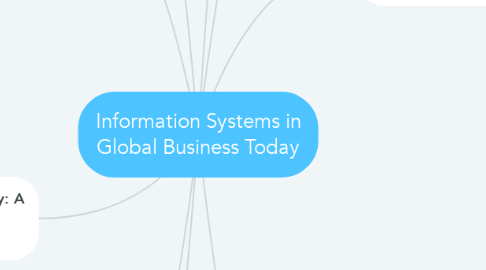
1. How Information Systems Are Transforming Business
1.1. In 2017, more than 140 million businesses had dot-com addresses registered
1.2. 273 million adult Americans online; 190 million purchased online
1.3. 269 million Americans have mobile phones
1.4. 200 million use social networks
1.5. Social networking tools being used by businesses to connect employees, customers, and managers
1.6. Internet advertising continues to grow at more than 20 percent per year
1.7. New laws require businesses to store more data for longer periods
1.8. Changes in business result in changes in jobs and careers
2. What’s New in Management Information Systems
2.1. IT Innovations : - Cloud computing, big data, Internet of Things - Mobile digital platform - AI and machine learning
2.2. New Business Models : - Online streaming music and video - On-demand e-commerce services
2.3. E-commerce Expansion : - E-commerce expands to nearly $1 trillion in 2018 - Netflix now has more than 125 million U S subscribers - Online services now approach online retail in revenue - Online mobile advertising now larger than desktop
2.4. Management Changes : - Managers use social networks, collaboration tools - Business intelligence applications accelerate - Virtual meetings proliferate
2.5. Firms and Organizations Change : -More collaborative, less emphasis on hierarchy and structure - Greater emphasis on competencies and skills - Higher-speed/more accurate decision making based on data and analysis - More willingness to interact with consumers (social media) - Better understanding of the importance of I T
3. Globalization Challenges and Opportunities: A Flattened World
3.1. Internet and global communications have greatly changed how and where business is done : - Drastic reduction of costs of operating and transacting on global scale - Competition for jobs, markets, resources, ideas - Growing interdependence of global economies - Requires new understandings of skills, markets, opportunities - Challenges yes, but opportunities as well - Over half of the revenue of S&P 500 US firms is generated off shore - Information systems enable globalization of commerce
4. Strategic Business Objectives of Information Systems
4.1. Growing interdependence between: - Ability to use information technology - Ability to implement corporate strategies and achieve corporate goals
4.2. Firms invest heavily in information systems to achieve six strategic business objectives: 1. Operational excellence 2. New products, services, and business models 3. Customer and supplier intimacy 4. Improved decision making 5. Competitive advantage 6. Survival
4.2.1. Operational Excellence : Improved efficiency results in higher profits Information systems and technologies help improve efficiency and productivity Example: Walmart Power of combining information systems and best business practices to achieve operational efficiency—and over $485 billion in sales in 2017 Most efficient retail store in world as result of digital links between suppliers and stores
4.2.2. New Products, Services, and Business Models : Information systems and technologies enable firms to create new products, services, and business models Business model> how a company produces, delivers, and sells its products and services Example: Apple - Transformed old model of music distribution with iTunes - Constant innovations—iPod, iPhone, iPad, etc
4.2.3. Customer and Supplier Intimacy : Customers who are served well become repeat customers who purchase more Example: Mandarin Oriental Hotel - Uses I T to foster an intimate relationship with its customers, keeping track of preferences, etc. Close relationships with suppliers result in lower costs : Examples: Mandarin Oriental Hotel and J C Penney (in text) - J C Penney uses I T to enhance relationship with supplier in Hong Kong
4.2.4. Improved Decision Making Without accurate information: - Managers must use forecasts, best guesses, luck Results in: - Overproduction, underproduction - Misallocation of resources - Poor response times >Poor outcomes raise costs, lose customers >Real-time data improves ability of managers to make decisions. Example: Verizon’s web-based digital dashboard to provide managers with real-time data on customer complaints, network performance, line outages, etc.
4.2.5. Competitive Advantage - Often results from achieving previous business objectives - Advantages over competitors - Charging less for superior products, better performance, and better response to suppliers and customers Examples: Apple, Walmart, U P S are industry leaders because they know how to use information systems for this purpose
4.2.6. Survival Businesses may need to invest in information systems out of necessity; simply the cost of doing business >Keeping up with competitors : - Citibank’s introduction of A T Ms >Federal and state regulations and reporting requirements : - Toxic Substances Control Act and the Sarbanes-Oxley Act
